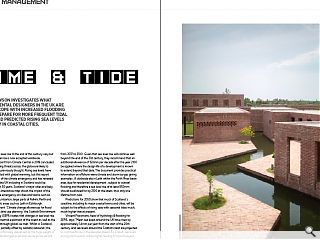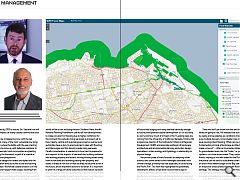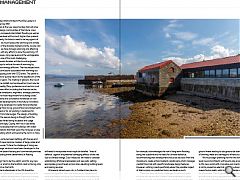Coastal Flooding: Time & Tide
22 Apr 2022
Leslie Howson investigates what environmental designers in the UK are doing to cope with increased flooding and to prepare for more frequent tidal surges and predicted rising sea levels especially in coastal cities.
Predictions of sea level rise to the end of this century vary but the fact of sea level rise is now accepted woldwide.
A scientific report from Climate Central in 2019 concluded that coastal flooding threats across the globe are likely to be far worse than previously thought. Rising sea levels have long been associated with global warming, but this report shows the impact of the climate emergency and has revealed that vital parts of the UK including in Scotland could be flooded within just 30 years. Scotland`s major cities are likely to be affected. An interactive map shows the impact of the unchecked climate emergency on cities and towns such as Clydebank and Dumbarton, large parts of Falkirk, Perth and Stirling and specific areas such as Leith in Edinburgh.
In their document `Climate change allowances for flood risk assessment in land use planning` the Scottish Environment Protection Agency (SEPA) states that changes in sea level rise are driven by the thermal expansion of the ocean as well as the addition of water through global ice melt. Whilst in Scotland, these impacts are partially offset by isostatic rebound ( the ongoing rise of land formally depressed by the huge weight of ice sheets during the last glacial period) sea level rise will still continue. The document provides the cumulative sea level rise from 2017 to 2100 . Given that sea level rise will continue well beyond the end of the 21st century, they recommend that an additional allowance of 150mm per decade after the year 2100 be applied where the design life of a development is known to extend beyond that date. The document provides practical information on offshore wave climate and storm surges giving examples . A dockside site in Leith within the Forth River basin area, due for residential development , subject to coastal flooding and therefore a sea level rise of at least 850mm should be allowed for by 2100 at the latest, thus only one lifetime from now.
Predictions for 2050 show that much of Scotland`s coastline, including its major coastal towns and cities, will be subject to the effects of rising seas with seasonal tides much, much higher that at present.
Vincent Fitzsimons, head of hydrology & flooding for SEPA, says: “Mean sea levels around the UK have risen by approximately 1.4mm per year from the start of the 20th century, and sea levels around the Scottish coast are projected to continue to rise in the decades ahead. As a result, sea levels during storm events will be higher, leading to more frequent and severe coastal flooding. …. the “credible maximum” sea level rise anticipated by 2100 is around 2m. Sea level rise will have a significant impact on many coastal communities and assets.
Globally, tidal rise is happening now, with the sea claiming the land in many of the most vulnerable low-lying areas of the world. where the battle with the sea is testing whole populations to come up with defensive solutions. In Bangladesh, for example, local communities are planting mangrove trees by the thousand, as part of a coastal re forestation protection programme.
Elsewhere new designs for levees and dykes and the creation of tidal marsh lands as buffer to the encroaching sea are being created. Worldwide coastal erosion is on the increase due to more frequent tidal surges, resulting from climate change and sea level rises and this is already having an impact on property and lives and bringing the location of future building developments into question. Taking on board current predictions, means that every coastal city in the world will be at risk including those in Scotland. Here, the 4th National Planning Framework calls for all new developments to make provision for flooding due to higher rainfall but for the moment this excludes rising sea levels, a prospect yet to face. Clearly, central and regional government as well as local authorities have a duty to enact policies to deal with flooding and tidal surges and this should include rising sea levels. Careful consideration is needed as to how best to prepare for and respond to the impacts of sea level rise; building resilience into existing property and assets, moving existing assets away from at risk areas and avoiding placing new property and assets in areas at risk now or that are likely to become at risk in the future, are all important actions to be taken. It is important to plan for a range of future outcomes so that robust decisions can be made as to what is appropriate to do in the present that doesn’t lead to greater impacts down the line,” says Fitzsimon.
Are government, local authorities, development companies and designers in Scotland, taking the likely impact of future tidal surging and rising sea level seriously enough to future proof planned coastal development or is it too early to worry and how much of a threat is this ? Leading ideas are coming from the University of California, Berkeley. Kristina Hill, programme director of the Institute for Urban and Regional Development (IURD) and associate professor of landscape architecture and environmental planning and urban design, specializes n urban ecology and hydrology in relationship to physical design.
Her primary area of work focusses on adapting urban districts and shore zones to the challenges associated with climate change, primarily tidal rise especially on cities facing the Pacific Rim. This work has highlighted the potentially catastrophic effects of sea level rise and tidal surge on contaminated sites, ground water inundation and ground liquefaction, all issues which will dictate the future placement and design of coastal buildings. She asks how will coastal cities adapt to rising sea levels.
Since we don’t yet know how fast and how high sea levels are going to rise, Hill stresses that our strategies must be ready and be adaptive as conditions change. Rising seas pose multiple dangers. Groundwater rises on top of sea level causing inland flooding. What can we do to prepare? A fundamental principle of landscape architecture -- “dig a hole, make a mound” -- offers a time-tested strategy, she argues. As groundwater levels rise, the “holes,” i.e. ponds and canal systems, can store excess water. They contain and re-direct floods, helping us live with water like the Dutch. The earth from the ponds can be used to build levees called super dikes, with an extra-wide wetland edge on the Bay side. Floating housing on the ponds would protect from both flood and earthquake damage. This strategy would solve both housing needs and environmental concerns, aligning interests that are often opposed while adapting to a changing climate.
In his 1997 blog Sea Level Rise Now, John Englander, widely respected oceanographer, consultant and leading expert sea level, stated that Architects Must Be Leaders in adapting to sea level rise 1997.
“We need to look at the new opportunities that will arise out of the need to design communities of the future, ones that can sustain the increased intermittent flooding as well as the new era when sea level will be much higher than present, essentially permanently. Architects need to be key agents of that change. Whilst we must reduce the warming and climate change as a matter of the absolute highest priority, we are now in a situation where we have to begin planning and effecting adaption in parallel with any efforts to slow the warming. Of all the adaptation issues, rising sea level and the unstoppable shifting shoreline is one of the most challenging.
Over the last several decades architects and engineers have focused on ways to reduce the rate of warming by making buildings more energy efficient. That has helped slow the greenhouse gas emissions associated with warming but we have passed a tipping point with CO2 levels. The planet is in a new state unable to quickly return to the equilibrium of the last eleven thousand years. The melting of glaciers, the rise of sea level and extreme rainfall can be slowed but must now be accepted as a new reality. Many professions and sectors must be engaged in this new effort including the financial sector, planners, real estate developers, engineers, strategic planners, national security, and those responsible for building codes.”
Much is being done and considered worldwide on how best to create coastal developments in the future. Innovative design ideas are being developed to create flood protected buildings, with upper floor living, ground floors and basements being lightly occupied or for car parking in readiness for periods of flooding from tidal surges. The design of building typologies close to the sea are being re thought with the flooding of the lowest levels being accepted and usage being modified accordingly. Coping with rise in sea levels may also mean more development of buildings with water displacement foundations that float upon the rising sea or else are permanently floating which will become the norm in many locations.
Holland has for centuries been battling with the sea and as a result the Dutch have become masters of large-scale land reclamation from the sea. To face the challenge of rising sea levels innovative design solutions have been developed in the construction of shore-based housing and commercial premises close to the sea including entire settlements of floating housing.
“Future proofing” has to be the watch word for any new development large or small on the Scottish coast or facing onto major estuaries, such as the Forth.
All environmental professionals in the UK should be thinking of innovation solutions for coastal protection and in the design of shore-based developments, especially housing settlements; thinking about not only where we build but in what form. At larger scales, any new coastal development will need to incorporate what might be labelled `lines of defence` against the potential damaging effects of the sea due to climate change. Such measures will need to consider establishing offshore breakwaters and sea walls, setting appropriate ground levels across sites, elevating building levels and raising services
At present almost every city in Scotland has plans to expand along either their river estuaries or shoreline and most are already including flood prevention and protection measures in line with recommendations from such as SEPA. The Granton Waterfront Development Framework 2020 for example, acknowledges the risk of long-term flooding along the coastline and the need for climate resilience, recommending that development should be set back from the shoreline to create a flood resilient coastal park which manages coastal flood risk with specific landscape design features. However, nothing is said specifically about the possible impact of tidal surging nor predicted rising sea levels as such.
There are many technical challenges to be faced which in future will require that Scotland take advantage of global expertise in both civil engineering and building solutions and to develop an understanding of the effects of tidal pressure on ground water leading to sub ground de stabilization, pollution of drinking water and damage to infrastructure overall.
We must begin planning now for the inevitability of sea level rise and architects will have to play a key role in adapting to this new world with innovative and practical solutions .This is not to present an alarmist view nor a doomsday scenario but means facing reality with innovative design solutions and as far as possible, “future proofing” waterfront developments and architecture by ensuring protection measures are incorporated in the project planning process and which will prove sustainable for the lifetime of each development.
|
|





